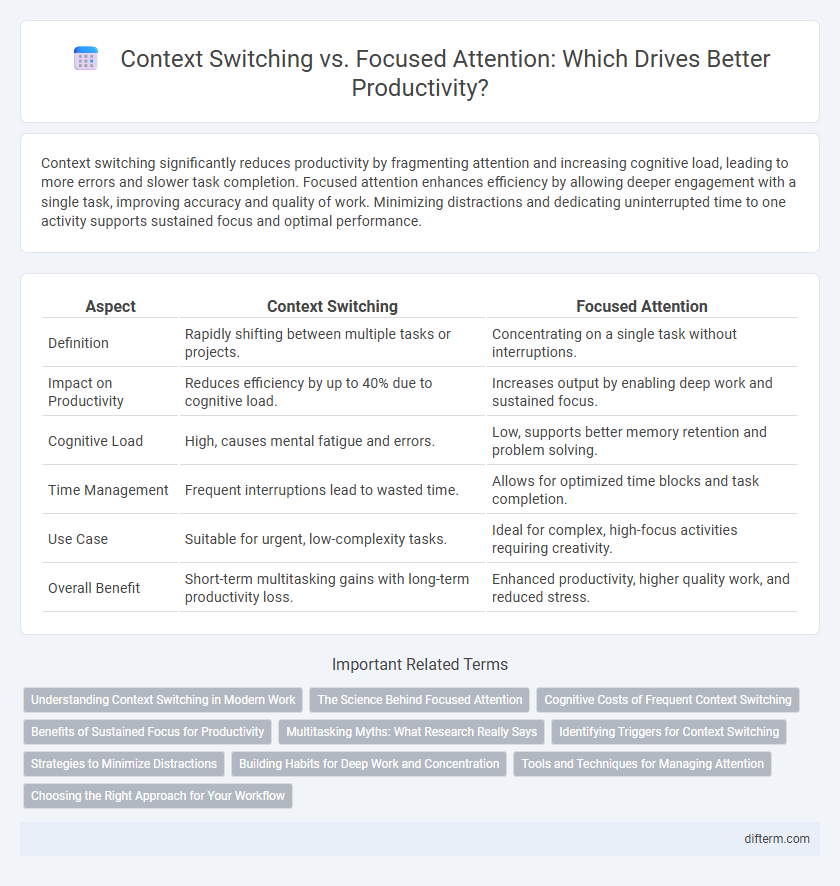Context switching significantly reduces productivity by fragmenting attention and increasing cognitive load, leading to more errors and slower task completion. Focused attention enhances efficiency by allowing deeper engagement with a single task, improving accuracy and quality of work. Minimizing distractions and dedicating uninterrupted time to one activity supports sustained focus and optimal performance.
Table of Comparison
| Aspect | Context Switching | Focused Attention |
|---|---|---|
| Definition | Rapidly shifting between multiple tasks or projects. | Concentrating on a single task without interruptions. |
| Impact on Productivity | Reduces efficiency by up to 40% due to cognitive load. | Increases output by enabling deep work and sustained focus. |
| Cognitive Load | High, causes mental fatigue and errors. | Low, supports better memory retention and problem solving. |
| Time Management | Frequent interruptions lead to wasted time. | Allows for optimized time blocks and task completion. |
| Use Case | Suitable for urgent, low-complexity tasks. | Ideal for complex, high-focus activities requiring creativity. |
| Overall Benefit | Short-term multitasking gains with long-term productivity loss. | Enhanced productivity, higher quality work, and reduced stress. |
Understanding Context Switching in Modern Work
Context switching in modern work environments refers to the frequent shifting of attention between different tasks, which significantly impairs cognitive performance and reduces overall productivity. Studies show that the average worker switches tasks every 3 minutes, leading to increased error rates and longer completion times due to the mental overhead of refocusing. Minimizing context switching by prioritizing focused attention enables deeper engagement, enhances problem-solving abilities, and fosters sustained concentration that drives higher-quality output.
The Science Behind Focused Attention
Focused attention activates the prefrontal cortex, enhancing cognitive control and reducing neural noise, which improves information processing and decision-making. Studies show that minimizing context switching lowers the brain's executive load, allowing for deeper work and better long-term memory consolidation. Neuroscientific evidence reveals that sustained focus boosts dopamine release, reinforcing motivation and supporting sustained productivity.
Cognitive Costs of Frequent Context Switching
Frequent context switching significantly increases cognitive costs by forcing the brain to repeatedly reorient and manage different tasks, reducing overall productivity. Studies show that each switch can cost up to 40% of productive time due to the mental load involved in refocusing and memory recall. Maintaining focused attention minimizes these cognitive costs, enhancing efficiency and task accuracy.
Benefits of Sustained Focus for Productivity
Sustained focus significantly enhances productivity by enabling deeper cognitive processing and reducing the mental cost of context switching. Concentrated attention improves accuracy, accelerates problem-solving, and facilitates the completion of complex tasks with higher quality. Maintaining prolonged focus helps create momentum, minimizes distractions, and supports efficient use of time, leading to greater overall work output.
Multitasking Myths: What Research Really Says
Research debunks the multitasking myth by revealing that context switching significantly reduces productivity due to cognitive overload and increased error rates. Studies show that focused attention improves efficiency, as the brain performs better when concentrating on a single task rather than juggling multiple tasks simultaneously. Neuroscientific evidence indicates that multitasking slows mental processing and hampers memory retention, emphasizing the need for sustained focus to enhance work quality.
Identifying Triggers for Context Switching
Identifying triggers for context switching is essential to enhance productivity by minimizing disruptions caused by task changes. Common triggers include frequent notifications, environmental distractions, and unclear task priorities, which fragment attention and reduce cognitive efficiency. Implementing strategies such as setting specific time blocks for tasks and controlling digital interruptions can help maintain focused attention and improve overall work performance.
Strategies to Minimize Distractions
Minimizing distractions requires strategies like time-blocking and creating a dedicated workspace to reduce context switching, enabling sustained focused attention. Techniques such as turning off non-essential notifications and using tools like the Pomodoro Technique help maintain deep concentration on tasks. Prioritizing single-tasking over multitasking enhances productivity by preserving cognitive resources and preventing mental fatigue.
Building Habits for Deep Work and Concentration
Building habits for deep work enhances productivity by minimizing context switching, which disrupts cognitive flow and reduces efficiency. Consistent practice of focused attention trains the brain to sustain concentration over extended periods, increasing the quality and depth of work produced. Implementing structured routines and time-blocking techniques supports habit formation that fosters uninterrupted, high-impact work sessions.
Tools and Techniques for Managing Attention
Productivity is significantly enhanced by minimizing context switching through techniques such as time blocking and the Pomodoro method, which allocate uninterrupted intervals for focused work. Tools like task managers (e.g., Todoist, Trello) and distraction blockers (e.g., Freedom, Cold Turkey) help maintain attention by reducing interruptions and organizing tasks into clear priorities. Implementing these strategies supports sustained cognitive engagement and improves overall efficiency in task completion.
Choosing the Right Approach for Your Workflow
Context switching reduces efficiency by fragmenting attention and increasing cognitive load, which can lead to slower task completion and more errors. Focused attention enhances productivity by allowing deeper immersion and better quality output, especially for complex or high-priority tasks. Selecting the right approach depends on the nature of your workflow, favoring context switching for multitasking environments and focused attention for tasks requiring sustained concentration.
Context switching vs Focused attention Infographic

 difterm.com
difterm.com